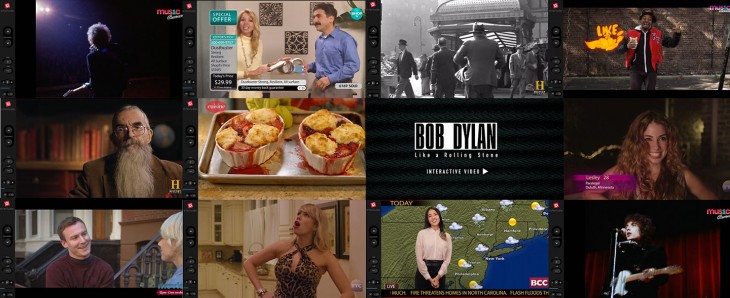
Erika Trautman is the CEO and co-founder Rapt Media.
Between Pharrell’s “Happy” music video and the video for Bob Dylan’s “Like a Rolling Stone,” interactive video (IV) is undoubtedly hot this year. IV breaks through the noise, gets people talking, and gets more views. The real value, however, is that those views are longer and more engaged.
But with interactive videos like Pharrell’s and Dylan’s setting the bar high, it’s easy to assume that only rockstar creative teams with monster budgets and months upon months of planning can create an IV, leaving those new to Interactive Video wondering where to even begin.
As one of the first companies in the IV industry, we’ve seen IVs of all types created – some with deep budgets and large production crews, and others with leaner budgets and just a few smart team members – and we know that with the right knowledge and tools, any company can create a powerful IV quickly and easily.

So what do you need to know to build your own IV? From choosing an IV platform that’s right for you, to figuring out where to put your first choice point, here are our 11 top tips to keep in mind to create a successful and engaging interactive video.
1. Set your objectives
Start by setting objectives for the video and the campaign. What are your business and creative goals? Are you looking to increase viewing time, amount of subscriptions, shopping cart completion rates? Do you want it to work on all devices? Is it important to be able to replicate it easily in different languages?
Sit down and list out all of your objectives before you even begin creating the idea so that your creative vision will achieve those goals.
2. Devise a concept to match those objectives
Design your interactive experience with your business or creative goals in mind. Interactive video is like a guided tour for your viewer where they get to choose what sites to visit, but it’s still a curated experience and must be informed by the outcome you want to achieve.
That said, during this phase, it’s important to remember that interactivity, first and foremost, should add value for your viewer. Is the interactivity fun? Does it add relevant information and make the content easier to consume? Or is it annoying? Avoid the latter.
Put yourself in the shoes of the viewer. Would you want to keep clicking through the video? If not, adjust the storyline to make it more engaging or more useful. Providing the viewer with value first rewards you with engaged viewers and better business outcomes.
3. Decide on your technology solution early in the production process
Different IV technologies have different capabilities. It’s a good idea to scope out what technical requirements matter to you early in the process so that you can pick a technology solution and then produce your content to work within the functionalities available on that platform.
Is it more important that your IV can be distributed in a Flash ad-network, or do you need to reach your audience on every device, including mobile? Depending on your answer, you’ll be looking for different solutions.
4. If mobile matters, check the experience

Today, over 20 percent of video views are happening on mobile devices, and that trend is growing quickly. According to a recent eMarketer study, more than 77 percent of all tablet users will watch video programming on their devices at least monthly, and that penetration rate will grow to 87 percent by 2018, totaling 149 million tablet video viewers.
To put that into context, that means more than 70 percent of all digital video viewers will be watching on a tablet four years from now.
But the mobile environment is fragmented, and not all mobile-compatible solutions are the same. Some interactive video technologies are limited to downloadable apps, while others work natively in the mobile web and can be distributed with a URL. Others still have simplified versions for mobile playback, directing viewers to watch the video on a desktop at a later time.
Ask the technology provider for a few examples of mobile interactive videos, and test those experiences yourself on a few different devices to see if the technology will meet your needs.
5. Choose a scalable IV technology
Certain platforms make it easy to iterate on your IV projects, quickly making changes by uploading new videos, switching out the old ones, and publishing to the live site. For example, a clothing brand using interactive video to engage customers could simply replace its video files each time a new line comes out, enabling the company to keep the same video format (if they so choose), and update the content on the fly – meaning all that initial effort invested in IV pays off over many, many videos.
Aim for a technology that’ll make your life easier when it’s time to update your video.
6. Make your first choice point count
Put your first choice point early in the video to entice viewers – somewhere between five seconds and 45 seconds is ideal. Interactive video is redefining how viewers engage with video content, and one of its clear advantages over linear video is the ability to control the experience.
In our experience, once a viewer interacts the first time, he or she is likely to stick around for the whole experience, even watching the video more than once. So hook them with a good first interaction.
7. Limit your number of choice points
With your first choice point in place, it’s time to position the remaining choice points throughout your video. Remember that on-screen choices or interactions take up real estate, so make them count.
A good guideline is to use up to three choices or interactions at a time. You don’t want your viewer to feel overwhelmed with choices and lose interest.
Once you’ve built your interactive video project using the IV editor of your choice, the next step is to test it. Go through the video to make sure there are no errors, like rogue video branches that lead you to a dead-end in the storyline.

8. Make sure your distribution is aligned to the campaign
Where do you want your viewers to experience the video? On social channels? In paid placement? On your own website? Or maybe a combination of all the above? Think strategically.
9. Iterate, iterate, iterate
Monitor and optimize the project. One of interactive video’s best features it that you can easily update your video if you’re not seeing the results you want.
It might be something as simple as changing the position of your first choice point, or changing the language on the buttons to further entice people to click.
10. Create with spotty mobile service in mind
Having a video that’s accessible on all devices, including mobile, is a huge asset, but make sure it’ll play well in less-than-ideal conditions.
Plan for poor WiFi and poor cellular data environments by keeping the entire page light and easy to load. Try to limit plug-ins, add-ons, extra JavaScript, and heavy images to make it lightweight.
11. Make sharing easy
Take advantage of our social tendencies on both mobile and desktop by including social sharing buttons. Embed social sharing right into the video content both at choice transition points in the project and always at the end.
And that’s it! These 11 tips will help you create an interactive video that’s not only engaging, but will help you meet your goals for online video interaction.
Any questions? Let us know in the comments below.
Get the TNW newsletter
Get the most important tech news in your inbox each week.




